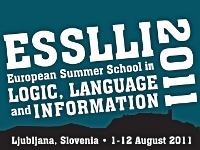
Workshop held at ESSLLI 2011
Ljubljana, Slovenia
1-5 August 2011

Abstracts.
Tutorial on Forcing.Gregor Dolinar. Univerza v Ljubljani, Slovenia.
Tutorial 3.1. We briefly overview the ZFC theory and the notion of independence of an axiom from some theory. then we prepare ground for the method of forcing by focusing on countable transitive models and their properties.
Tutorial 3.2. We define forcing notion, generic sets, forcing names and generic extension. We present the forcing theorem.
Tutorial 3.3. We focus on collapsing and preservation of cardinals, chain conditions, closedness. We show several uses of forcing.
Tutorial on Descriptive Set Theory.
Martin Goldstern. Technische Universität Wien, Austria.
Tutorial 2.1. The real numbers, the Cantor set, Baire space. Open set sets, closed sets, Borel sets, Borel maps.
Tutorial 2.2. Analytic sets and coanalytic sets. The perfect set property and other regularity properties.
Tutorial 2.3. Some connections to (small) large cardinals.
MAD families and the projective hierarchy
Yurii Khomskii. Universiteit van Amsterdam, The Netherlands.
A maximal almost disjoint (MAD) family is an infinite collection of infinite subsets of ω such that all its members are pairwise almost disjoint, and which is maximal with respect to this property. A typical MAD family is constructed using the axiom of choice, and does not have an explicit definition. A classical result of Mathias shows that there cannot be an analytic MAD family. In this work we investigate in which models of set theory MAD families of complexity Π11 and Σ12 exist. Such families were already known to exist in L and some forcing extensions, but the methods for constructing these were limited. (This is joint work with Jög Brendle, Kobe University, Japan).
Tutorial on Combinatorial Set Theory.
Jean Larson. University of Florida, U.S.A.
Tutorial 1.1. We review the Kőnig Infinity Lemma that infinite tree with finite levels has an infinite branch, use it to give a quick proof that for any coloring of the set of all edges of a graph on an infinite set of vertices with finitely many colors, there is an infinite subsets all of whose edges have the same color. We conclude with a discussion of a graph coloring theorem for finite graphs that requires a infinite perspective since it cannot be proved in Peano Arithmetic.
Tutorial 1.2. We introduce graph coloring problems for countable ordinals, review what is known for countable ordinals that are not the sum of two smaller ordinals, sketch a sample proof using a pictorial approach, and if time permits, describe a finite combinatorial problem whose solution would generalize the result sketched.
Tutorial 1.3. We survey some open problems in graph coloring.
Blass's game semantics for linear logic without the axioms of choice
Zhenhao Li. Universiteit van Amsterdam, The Netherlands.
Andreas Blass gave a game semantics for linear logic in his 1992 paper, based on his earlier analysis of the degree structure of infinite games. Blass's work heavily depend on the Axiom of Choice. This paper will investigate the Blass game semantics in axiomatic systems such as ZF and ZF+AD. The goal is to explore logics generated from the game semantics in these axiomatic systems of set theory.
Classification in descriptive set theory
Alberto Marcone. Università di Udine, Italy.
Descriptive set theory computes the complexity of a 'natural' set by assigning it to the appropriate level of the Borel or projective hierarchy by using Wadge reduction. We give some simple examples of this useful technique. If time permits, we describe also the more complex task of classifying binary relations (in particular equivalence relations) by means of Borel reducibility.
Half-filling families of finite sets
Grzegorz Plebanek. Uniwersytet Wroclawski, Poland.
Denote by Fin(X) the family of all finite subsets of a given
space X.
A hereditary family A contained in Fin(X) is
half-filling on X if every set b from Fin(X)
contains a subset a which is an element of A and
has at least (1/2)|b| elements.
The main problem concerning half-filling familes was posed by David
Fremlin
and
reads as follows: does every half-filling family on an uncountable
space X
has an infinte homogeneous set Y?
We discuss the original problem and some of its variants connected
with measure theory.
Rado's Conjecture and special ω2-Aronszajn trees.
Victor Torres Perez. Universität Wien, Austria.
We say that a tree of height κ is special iff it is the union of less than κ antichains. Rado's Conjecture (RC) is the following statement: A tree T of height ω1 is special if and only if every subtree of T of size ω1 is special. It was proven by Todorcevic that RC is independent of ZFC. Also, he proved that RC implies the continuum is at most ω2, but it cannot decide the exact value. We prove that under RC, CH is equivalent to the existence of a special ω2-Aronszajn tree.